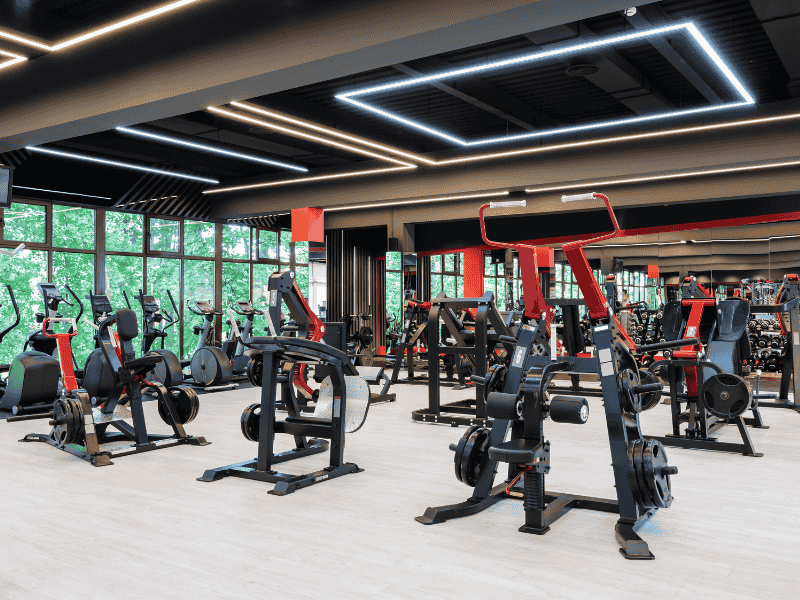How to Find the Best Location for your Gym

The decision of where to locate your gym is probably the single biggest you’ll make in the life of your business. Get it right and you’ll be establishing a foundation from which to build a thriving business, with access to a steady stream of members from your target market. Get it wrong, and you may well be unwittingly putting a millstone around your gym’s neck which it will never be able to remove.
In this article, we’ll provide guidance from in the trenches to help you find and negotiate the best location for your gym.
Establish the Right Mindset
When it comes to the best locations to open a gym, there are essentially two types of gym locations, that we can label an ‘A’ location and a ‘B’ location. An ‘A’ location is that ideal position that consists of a ready-fitted, relatively new building, great traffic flow, and that allows for great signage display. The problem with these locations is that they are very expensive, costing, depending on where you are, as much as a hundred dollars per square foot.
Your other option is to go for a B location. Now, this building might be no more than half a mile away from the A location. Yet, it doesn’t have the same sparkle to it. It’s not as new, not as custom fitted, and doesn’t have the same traffic flow. But when you draw a circle around your pull area, it is pretty much the same as if you paid a lot more for the ‘A’ location.
The mindset that I have always operated from is to do more with less. If you choose a less ideal location within the same market pull area and maximize its potential, you will be paying a significantly reduced monthly rental. If you keep an open mind and focus on the potential of the building, it is possible to secure a 15,000 square foot building for around $10 per square foot in some parts of the United States.
The key point here is that the lower your fixed overhead, the more readily you will be able to weather the inevitable financial storms that will come your way.
It is important to keep this mindset when you are working with real estate agents. They will naturally steer you towards the Type ‘A’ gym locations; after all, their mindset is fixed on their commission! Don’t allow yourself to be swept up by their spin.
Take the Initiative
To find the ideal location for your gym, you sometimes have to be a little bold. A friend of mine was once looking for a building to open his second gym. He had identified the area and had spent a couple of weeks with a real estate agent checking out buildings that were for lease. They were either too expensive, too small, or too ill-shaped.
Then, one day, he was cruising the area by himself when he came across what appeared to be the ideal building. It had great visibility, being located on a hill, allowing for terrific signage display. It had plenty of parking, good traffic flow, and looked to be the right size. The only problem was that it wasn’t for lease.
My friend took the initiative and knocked on the door. He introduced himself and told the guy what he was planning to do. It turned out the guy was a gym junkie. He loved the idea of a local gym and agreed to sublease at a very good rate.
The message - you have got to be proactive. If you see a building that looks great, go in and make inquiries - you never know what’s going to happen!
5 Questions
When considering your location, here are 5 questions to ask yourself:
- Does the location satisfy your target market?
- Does the street have heavy traffic?
- Is the site visible from the street?
- Is the location convenient?
- Is there enough room for parking?
Selecting the right location for your new gym begins with knowing the demographics of the area and knowing your target market. To make this match, you must first take the time to create a series of buyer personas.
A buyer persona is a semi-fictional mock-up of your ideal client. The buyer persona helps you to understand where your client is coming from, and what her pain points and challenges are. With the person as your guide, you will more easily be able to tailor everything you do to match the needs of your clients.
Your buyer persona is based upon research and educated speculation. In order to create a realistic buyer persona, you will have to do some market research. Conduct an informal survey, trying to speak to between 5 and 10 people who fit your target market.
Ask them about their . . .
- Work – what their job title is / what their job involves / what hours they work
- Health and Fitness Goals – what is their major concern / what would make them feel successful / what sports do they enjoy / what health challenges do they face
- Social – What are their main sources of new information / what social media sites do they frequent / what are their preferred means of communication
- Family – are they married/do they have children
With this information in hand, you are ready to create your buyer persona.
Now, with your buyer personas in mind, research the demographics of your potential gym location. Does the median income of the area match your buyer personas? What about the median age group? If you don’t see a match, you’re going to struggle to get the clientele that you want.
Narrowing down on the actual location, check to see what other businesses are in the area that will draw in a constant flow of people in your target market. Ideally, you want something like a supermarket to be across the road. Being part of a strip mall should also see a constant flow of traffic coming by.
Ideally you’ll want a ground floor location with large window frontages where passersby can see the action going on inside the gym.
The Building
When you’re checking out a potential gym building, you should have a clear idea of how much space you will need for the different areas; the administrative space, the gym floor, the shower, and locker rooms, and the relaxation lounge. Plot out those areas and then walk through the facility from the perspective of your potential clients. Do the training zones naturally extend from the reception area. Is it going to be user friendly?
Check the location of power points and plumbing. How much work is going to be required to remodel the building and does this align with your remodeling budget?
Does the building have high ceilings? This will make the space appear much larger, is better for air circulation, and promotes a more positive vibe than low ceilings. High ceilings will also be a necessity if you are planning to install climbing ropes.
Check how much natural light comes through - the more the better. If you can’t let much natural light in, make sure that you do a good job of artificially lighting up the workout areas of your gym.
It is imperative that you thoroughly acquaint yourself with the building rules and codes. Obviously, the building must be classified for commercial use. You also need to check that there are no noise or other caveats in operation that will restrict the normal running of your gym. Determine, too, whether you will have to make any changes to comply with the local fire regulations.
Make sure that you check on the occupancy capacity of the building. You never want to be in a position where you’ve got potential members ready to join up but can’t take them because you neglected to check if the building had a maximum occupancy.

Competition
Research the fitness facilities that are covered by your catchment area. This includes yoga studios, boutique gyms, personal training studios, and boot camps. Don't, however, write off a location just because there is a boot camp studio around the corner. It’s quite possible that such a business could actually work as a complementary rather than a competitor business.
Complimentary businesses are those that you can work with for cross-promotional benefit. While not being direct competitors, they will operate within the general health products or services industry. An example could be a chiropractor. You may be able to establish a relationship with this business where you each offer special discount rates, promote the other business to each other’s members and do joint promotional campaigns.
While researching a potential location, look for complementary businesses that you can work with.
Negotiating the Lease
The first point that needs to be stressed when it comes to your lease is that you should not just turn up and sign it. Always get professional advice from an attorney who is experienced in commercial lease negotiations. You should also understand that leases are almost always open to negotiation.
Do your homework before you start negotiating. You should obtain a full understanding of what is in the lease contract. Be very clear, also, on what your lease requirements are. Know how much space you require as well as the extent of renovations that will be required to get the facility gym ready. You should also have a good idea of how long it will take from getting the keys to having your grand opening.
It may sound obvious, but make sure that you have specific permission from the landlord to operate a fitness business from the site. Ensure, too, that any offer you make is subject to council approval.
Prior to negotiating with the landlord, you need to be well aware of your costs. Make sure that you have covered all of the incidentals that you are being asked to pay to ensure that the total costs will meet your budget. Incidental costs may include the requirement to pay a rental deposit. Check also to see if the contract includes a ‘make good’ clause where you're required to return the building to the state it was in when you were handed the keys. This can add a major sting to your exit from the business location.
Understand your lease options. The costs that are included can vary considerably. With a gross rent lease, for example, you pay a single amount that covers the core rent as well as all the incidentals. These may include things like insurance, property taxes, repairs, maintenance, and any shared expenses that relate to common spaces. In a net lease situation, you agree to pay the incidental costs directly as they arise.
If you lease a space in a shopping mall, it is likely that the landlord will favor a percentage rent lease. This is where you are charged a base lease plus a percentage of your sales.
Know the market rates when you go into the lease negotiation. Check with two or three commercial rental agencies in your area to get a clear idea of the commercial rates being charged.
You should also do as much research as you can on the building before meeting with the landlord. Make sure that the surrounding businesses are compatible with your business (do you really want to set up your business under a strip joint?).
Talk to other businesses in the area to determine if there are any potential issues that may not be obvious. An example could be that there is a major roading construction project planned to begin in a few months. This could dramatically affect your business and, if you are aware of it, you can use it as a negotiating point with the landlord.
If you are able to contact previous lessees of the building, it pays to do so. Ask them if they had any issues that might bring up a red flag for you.
When you go into the lease negotiation, you should ask for 90 days of abated rent before the lease term kicks in. This will take you through your initial grand opening phase and allow you to build a core membership. A 90-day abatement will provide you with 3 months of heavy selling without having to contend with your major expense.
Ask, too, if the landlord is willing to finance all or part of the renovations required to get the location gym ready.
When it comes to the length of the lease, an initial 5-year term is pretty standard in the industry, renewable in 5-year increments. If you are buying into a franchise, make sure that the building lease marries up with the franchise lease; the last thing you want is to be having to pay extra rent after your franchise term has expired.
Make sure that you are very clear on the termination conditions of the lease. Know up front what will happen if you can’t pay the rent one month or if the landlord sells the building. If you decide to expand to a larger space, what will it take for you to break the lease? You should also include a clause that gives you first right of refusal if an adjoining space owned by the landlord becomes available.
You should also ensure that the lease includes an assignment clause. This allows you to transfer the lease to a third party without penalty. Finally, make sure that you are clear on the conditions around lease renewal.
Summary
When going through the process of choosing your gym location, do not allow yourself to be caught up with the attraction of an ‘A’ location that is going to provide you with all the bells but whistles but at a price that could cripple you. Take the time to do your research, then look for a location that has potential and that can be acquired for a price that works for you and your budget.
Your ideal gym location should answer the following questions…
- Does the location satisfy your target market?
- Does the street have heavy traffic?
- Is the site visible from the street?
- Is the location convenient?
- Is there enough room for parking?
Work through the answers to these questions, then, once you’re zeroed on a location, use our negotiation tips to get a deal that will work for you.
Gym management software that frees up your time and helps you grow.
Simplified billing, enrollment, student management, and marketing features that help you grow your gym or martial arts school.





